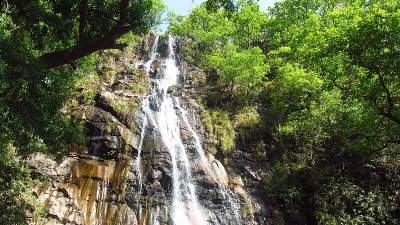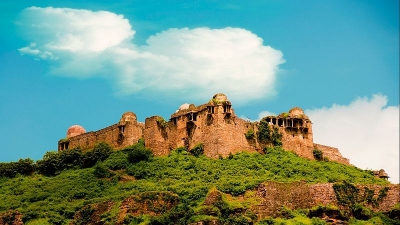Sanchi Attractions - Tourist Places To Visit In Sanchi
-
01Sanchi Stupa
+ Read MoreSanchi Stupa is a famous tourist spot located at the Sanchi village of Madhya Pradesh at a distance of 46 kilometres from Bhopal. There are three stupas and these stupas are the most well preserved all over the country. The first Sanchi stupa was constructed in the third century. Its height is around 16.4 m and it is about 36.5 m in diameter.
The second stupa was constructed in the second century and is situated at the margin of a hill above an artificial stage. The third Sanchi stupa lies near the first stupa and it possesses a crown on the semicircular dome which is considered to be a blessed place. All the three stupas of Sanchi are considered as World Heritage Sites and are presently under UNESCO.
From 8 am in the morning till 5 pm in the evening, all the three stupas remain opened for the public. It is true that all the three stupas are considered to be amongst the oldest stone structures of the world. There are audio guides available for the tourists and photography is also allowed in the three stupas.
-
02The Great Bowl
 + Read More
+ Read MoreThe Great Bowl is situated in Sanchi and is considered as one of the most excellent tourist attractions of Madhya Pradesh. The place is considered as a cradle of Buddhist renaissance as the name of the place was mentioned in several Buddhist documents and scripts. There is a huge area of magnificent monuments in Sanchi and these monuments reflect the spiritual customs of the past.
One of the amazing artistic grandeurs is captured in the bunch of monuments and the best among them is definitely the Great Bowl. The Great Bowl is one of the most precious relics and was the storehouse for food.
Foods were distributed amongst the monks from this bowl. The Great Bowl was made from a massive stone block and is considered as one of the finest examples of the Buddhist era.
-
03Ashoka Pillar
 + Read More
+ Read MoreAshoka Pillar located at Sanchi is recognised by the government of Madhya Pradesh as one of the most attractive tourist destinations of the state. The pillar consists of a shaft and a crown of four lions. These lions stand back to back and the pillar was erected in the 3rd century BC. It is true that at present one cannot get a glimpse of the whole pillar.
The shaft of the pillar can be seen at the gateways, but the crown is kept in the museum. The architecture of the Ashoka Pillar is said to be of the Greco-Buddhist style. The pillar is undoubtedly very well proportioned in nature.
The Ashoka Pillar at Sanchi has a lot of resemblance with the Pillar at Sarnath.The pillar is very well furnished. The pillar of Sanchi does not possess the Dharmachakra unlike the pillar of Sarnath.
-
04Four Gateways Of Sanchi Stupa
+ Read MoreFour Gateways of Sanchi Stupa have four sets of lions situated at the top of each pillar. It is true that when the stupas were planned the splendid gates were not included at first. A striking contrast is formed at the body of the stupa by the entrance gates. Each gateway is supported by a superstructure and three curvilinear architraves and intermediate parts.
The gates have one of the finest architectures and are covered with reliefs. All the four gateways of the Sanchi Stupa date back to the first century BC. The southern gate is the principal entrance, and it was built at first.
After that, the northern, eastern and western gates were built. There are scenes of Gautam Buddha’s birth embedded in the southern gateway and events from Samrat Asoka’s life as a Buddhist are also embedded in this particular gate. The architraves are supported with four pillars that have four lions on their top.
-
05Sanchi Museum
 + Read More
+ Read MoreSanchi Museum was established in the year 1919 by Sir John Marshall. The exhibits from the museum were shifted from the original place to a new building due to limited space. Aesthetic displaying of the objects are very important and that is the reason why the exhibits got shifted. There are four galleries and a main hall at the museum.
Most of the objects are from Sanchi and there are a few objects that were taken from its neighbourhood. One has to enter the museum from the main hall and the main hall acts as the main gallery.
A classical representation of the Sunga period has been displayed in the northern wall of the gallery and the image is of Nagaraja. The museum remains closed every Friday. One can visit the museum from 10 am to 5 pm.
-
06Buddhist Vihara
 + Read More
+ Read MoreBuddhist Vihara has always been considered as one of the finest centres of Buddhist culture. The vihara used to be the dwelling place of the Buddhist monks and was not made of wooden carvings. There is a large area for communal activities inside the vihara. The place is situated at a distance of a few kilometres from Sanchi and is considered to be one of the most important tourist sites of Madhya Pradesh.
The viharas have the remains of Satdhara Stupa. There is an inner chamber in the vihara where all the relics are reserved in a glass chest on a platform. There are many attractive features in all these viharas.
There are small cells inside the viharas, which have doors with two platforms to serve as beds. Hundreds of people from across the globe visit the place in order to get a glimpse of the Buddhist traditions.
-
07Gupta Temple
 + Read More
+ Read MoreSanchi’s Gupta Temple is known all over the world for its simplicity and is referred by the historians as one of the most logically designed structures of Indian architecture. The temple beautifies the middle layer of the Sanchi hill. The temple is from the fifth century AD and is considered as the esteemed epithet of the Golden era.
The structure portrays the outstanding development that was there in the arena of architecture during the Gupta period. The temple is an emblem of the rebirth of structural action in this place. The temple personified each and every precept that was thought to be valuable in the building of an Indian shrine.
The temple consists of a stylish plain-roofed chamber and there is also a covered entrance which is supported by pillars. The temple indicates the origin of temple architecture in the history of India.



 Click it and Unblock the Notifications
Click it and Unblock the Notifications





